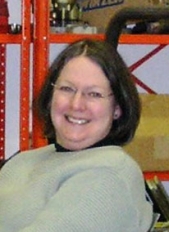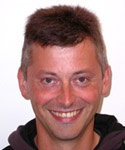Department of Computer Science
University of North Carolina at Chapel Hill
For the past 10 years the Effective Virtual Environments (EVE) research group at UNC has been investigating what is required of a VE system in order to create the illusion that you are someplace other than were you really are. We ask the question, “Do users act and perform tasks in a VE in the same way and with the same precision as they would in a comparable real-world scene?”; Our primary concerns have been the quality of the sensory stimuli immersing the users and the naturalness and usability of user interfaces. Aong the way there have been surprising results, surprising lessons-learned about doing user studies, and a surprising ability to fool the senses.
Mary C. Whitton is a research associate professor in the Department of Computer Science at the University of North Carolina at Chapel Hill. She has been working in the areas of high-performance graphics, visualization, and virtual environments since 1978. She was a co-founder of her two entrepreneurial ventures and worked in industry for 16 years. She joined UNC in 1994 and her research there focuses on what makes virtual environment systems effective and on developing techniques to make VEs more effective when used in applications such as simulation, training, and rehabilitation. Ms. Whitton was a member of the ACM SIGGRAPH Executive Committee for nine years, serving as President of the organization 1993-1995. She earned M.S. degrees in Guidance and Personnel Services (1974) and Electrical Engineering (1984) at North Carolina State University.
Framestore CFC
The role of software development in the production of computer animation & visual effects has changed over the years. Originally almost all effects were produced by programmers developing custom software, but since the early 90s the increased size of the industry has made it economic for off-the-shelf software to help artists produce the same effects.
Despite this, high end visual effects houses continue to find a need to develop their own proprietary software. This talk will describe the role of software R&D in current film production, outline how the nature of the role has shifted in recent years, and discuss how we make use of academic CG research.
Martin Preston is a lead software developer at Framestore (www.framestore-cfc.com), the largest visual effects and animation studio in Europe. There he leads the development of proprietary CG tools used in the production of effects for a variety of film and television projects (currently including 'Narnia' & 'Batman').
Martin received his Ph.D. from the University of Manchester in 1994, and
since then has worked in R&D for film & games. His film credits include
'Enemy at the Gates', the 'Lord of the Rings', 'I,Robot' & 'King Kong'.
Though the only film he's ever impressed anyone at a party with was
'Bridget Jones Diary'.
School of Earth, Atmospheric and
Environmental Sciences
University of Manchester
Geology is an inherently 3 dimensional subject, though until recently most geological problems have been dealt with in 2 dimensions, with the tool of choice for the geologist being the 2D map and the cross section. These forms of presentation, though very useful, can quite often be misleading and in some cases have led to incorrect, and sometimes geologically impossible, interpretations as the 3D nature of the subject has been ignored. Geologists are more commonly working in 3D now as the equipment allowing data to be recorded in 3D while in the field (eg. DGPS and LiDAR) is cheaper and more accessible, though progress is still held back by lack of appropriate software and interpretation for the field geologist who wishes to work in 3D.
Terrestrial Laser Scanning or LiDAR is a system for mapping structures
in three dimensions. Though developed mainly for civil engineering
applications the use of LiDAR is becoming more common in geology,
allowing us to access geological exposure previously inaccessible
(e.g. high up on a cliff face) or allowing us to bring the virtual
version of the exposure into the lab for interpretation, or to be used
for teaching. The challenges now lie in making the data easier to use,
and not just to be treated as pretty pictures but as a useful
scientific tool. We are addressing this issue by developing our own
software Virtual Reality Geological Studio (VRGS) to make handling the
datasets easier, and also to allow the geologist to interpret the data
in a way that is meaningful to a geologist, rather than relying on
tools designed for non geological applications. The importance of good
visualization has become increasingly apparent during the development
of the software, as has the use of stereo visualisation, though as a
driver for the improved interpretation techniques rather than as an
end in itself.
David studied Geology at the University of Durham, after which he went
on to do an MSc in Computing in Earth Sciences at the University of
Keele. He stayed at Keele to do a numerical modeling PhD, followed by a
Post Doc in 3D geological structure modeling. He then moved to Liverpool
University and worked as a post doc for 7 years, working on a diverse
range of geological problems in both sub-surface and outcrop settings.
He came to the University Of Manchester in 2003 to take up a post as a
lecturer in Petroleum Geology and Reservoir Modeling as part of the
Basin Studies and Petroleum Geoscience group, and with the purchase of
the groups terrestrial laser scanner system started to develop VRGS as a
tool for the field geologist.
He has worked on a variety commercial computer applications for the
earth sciences over the past years, as well as having computer games
published in the early 1980's.
In 2008 he has set up a spin out company called VR Geoscience, which
aims to make the use of virtual reality and 3D visualization of outcrop
data a useful technique for the hydrocarbon industry.

